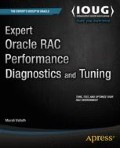Abstract
When optimizing Oracle database systems, the SQL statement, its explain plan, adding indexes, or changing the optimizers access paths, using hints, and so forth are just methods of helping Oracle to perform user operations. When all these tuned and optimized SQL statements are executed, there are other types of potential bottlenecks such as contention, concurrency, locking, and resource availability that could cause applications to run slow and provide slow response times to the users. Contention for resources could be measured or interpreted at the various levels of the systems processing cycle. Such resources could be lack of CPU, lack of network bandwidth, lack of memory, issues with the storage subsystem, and so forth. Oracle provides instrumentation into the various categories of resource utilization levels and provides methods of interpreting them. In this chapter, we look at some of these critical statistics that help optimize the database.
Access this chapter
Tax calculation will be finalised at checkout
Purchases are for personal use only
Notes
- 1.
Metalink Note # 22908.1. “What Are Latches and What Causes Latch Contention.” Accessed at metalink.oracle.com .
- 2.
Ibid.
- 3.
V$GES_LATCH is depreciated in Oracle Database 12c Version 1.
- 4.
Script source is Oracle Wait Interface: A Practical Guide To Performance Diagnostics & Tuning (2004, Oracle Press) by Richmond Shee, Kirtikumar Deshpande, and K. Gopalakrishnan.
- 5.
Uresh Vahalia, UNIX Internals: The New Frontiers (Prentice Hall, 1996).
- 6.
Metalink Note # 22908.1. “What are Latches and What Causes Latch Contention.” Accessed at metalink.oracle.com .
- 7.
For single-instance-related wait events, please refer to the book Oracle Wait Interface: A Practical Guide To Performance Diagnostics & Tuning (2004, Oracle Press) by Richmond Shee, Kirtikumar Deshpande, and K. Gopalakrishnan.
- 8.
Tierney, Brian L., Jason R. Lee, Dan Gunter, Martin Stoufer, and Tom Dunigan, “Improving Distributed Application Performance Using TCP Instrumentation.” Berkeley, CA: Lawrence Berkeley National Laboratory, May 2003.
- 9.
Underscore parameters should be modified only after consulting with Oracle support.
- 10.
Underscore parameters should be modified only after consulting with Oracle support.
- 11.
Tierney, Brian L., Jason R. Lee, Dan Gunter, Martin Stoufer, and Tom Dunigan, “Improving Distributed Application Performance Using TCP Instrumentation.” Berkeley, CA: Lawrence Berkeley National Laboratory, May 2003.
- 12.
Vallath, Murali. Oracle 10g RAC Grid, Services & Clustering. Digital Press, 2007.
- 13.
Underscore parameters should be modified only after consulting with Oracle support.
- 14.
Metalink Note # 1377998.1. “Troubleshooting: Waits for Mutex Type Events.”
Author information
Authors and Affiliations
Rights and permissions
Copyright information
© 2014 Murali Vallath
About this chapter
Cite this chapter
Vallath, M. (2014). Waits, Enqueues, and Latches. In: Expert Oracle RAC Performance Diagnostics and Tuning. Apress, Berkeley, CA. https://doi.org/10.1007/978-1-4302-6710-2_17
Download citation
DOI: https://doi.org/10.1007/978-1-4302-6710-2_17
Published:
Publisher Name: Apress, Berkeley, CA
Print ISBN: 978-1-4302-6709-6
Online ISBN: 978-1-4302-6710-2
eBook Packages: Professional and Applied ComputingProfessional and Applied Computing (R0)Apress Access Books

